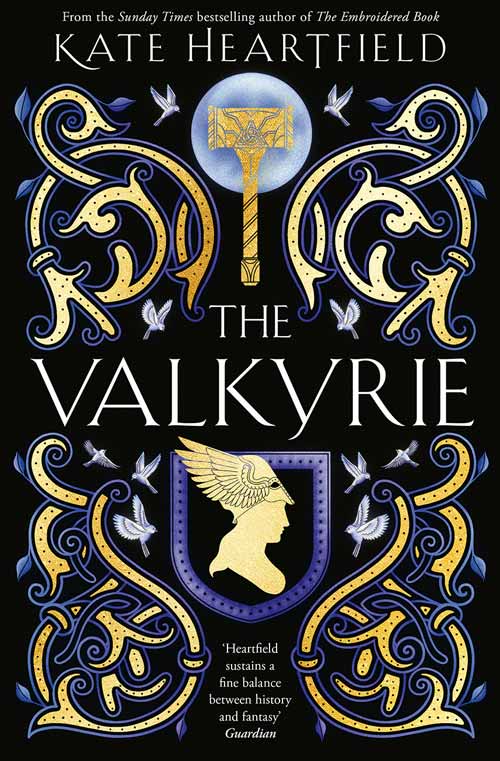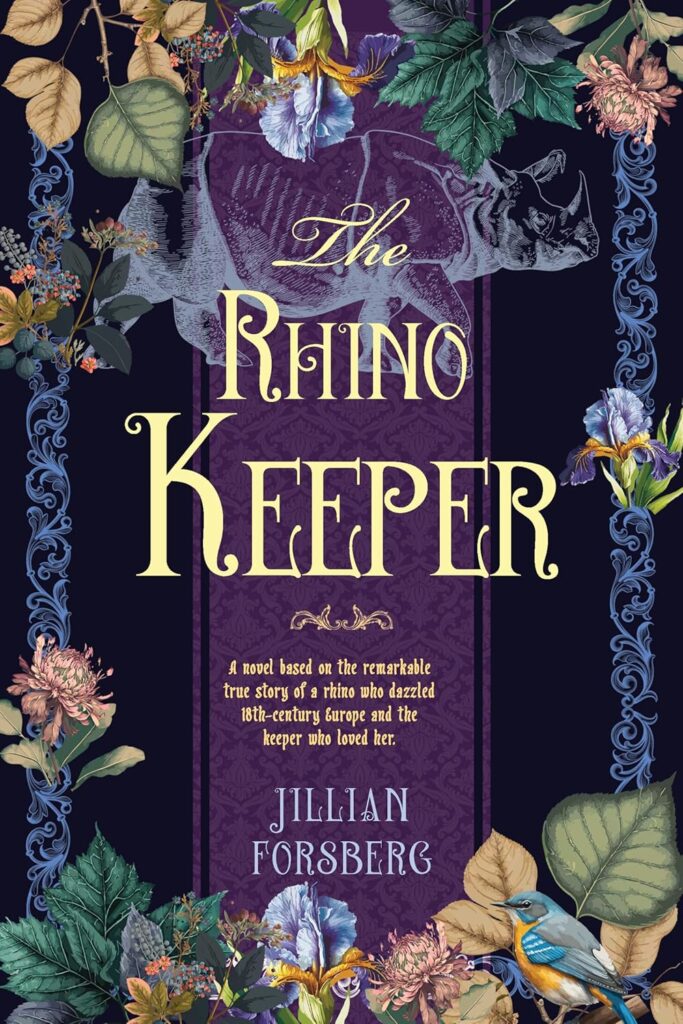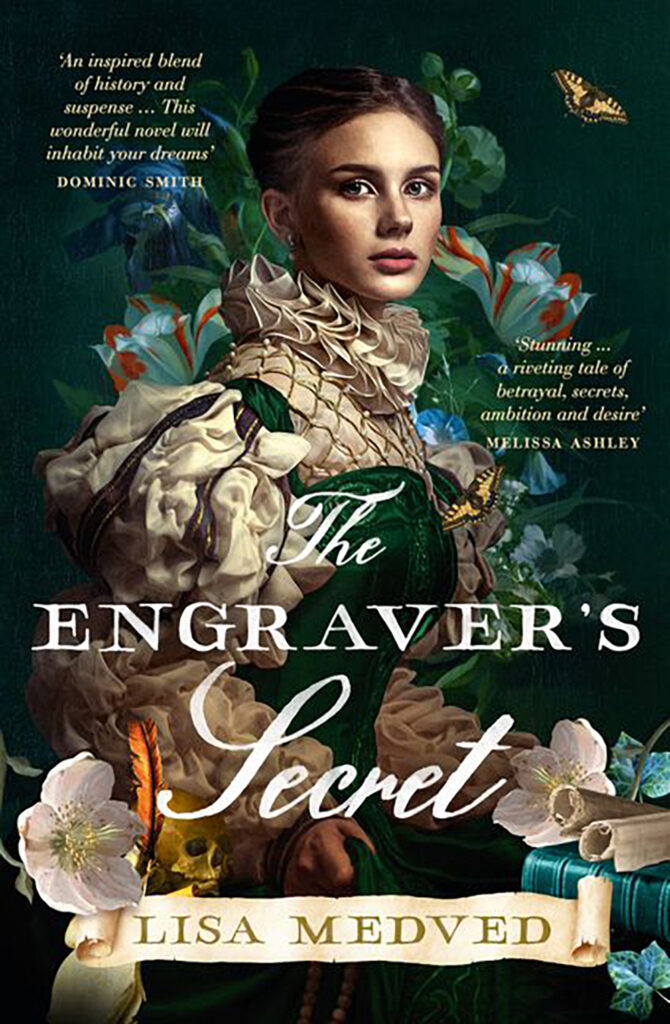Resources on Medieval and Renaissance Foodways

Large Still Life with a Lobster, Birds, Fruit, and Renaissance Goblets, by Jan van Kessel 1646-79 [public domain, Wikimedia Commons]
If you are setting your novel in the Medieval or Renaissance eras, you will likely have to research what your characters would eat. Here are some books and a few websites which provide research on historical food habits. I have included ISBN numbers for the books when available, to make it convenient to order copies through your favorite used book vendor or library.
RENAISSANCE EUROPE: BOOKS
The Banquet: Dining in the Great Courts of Late Renaissance Europe, by Ken Albala. University of Illinois Press, 2007. 9780252031335
“A history of western Europe told through the lens of food and fine dining…Why people ate as they did and what it reveals about them”—preface. A chronology spans 1520 to 1670. Examples of chapters: Dairy, Spices and Garnishes, Starches and Pasta, Staff and Carving, and Wine and Alcohol. A glossary, bibliography, and a few recipes are included.
Eating Right in the Renaissance, by Ken Albala. University of California Press, 2002. 0520229479
Albala examines dietary literature published between the 1470s and 1650 and “offers a view of what it meant to eat well and be healthy in the Renaissance…what people thought about food and its preparation, what they felt guilty about eating, and what ultimately was going on in their minds and bodies as they consumed food.”—Introduction. He addresses issues such as: Did they eat salad? Did they view tomatoes as poisonous? What did peasants eat? Includes an extensive bibliography.
Food and Knowledge in Renaissance Italy: Bartolomeo Scappi’s Paper Kitchens, by Deborah L. Krohn. Ashgate, 2015. 9781409446712
This work looks at Renaissance foodways through the lens of Scappi’s cookbook Opera dell’arte del cucinare, published in 1570. The author argues that the inclusion of engravings “brought food knowledge to a higher level” than previous cookbooks—p.1. A set of Scappi’s illustrations of cooking pots, knives, and other utensils would be useful to a novelist writing a scene in a Renaissance kitchen. There are also engravings of the layout of Renaissance kitchens.
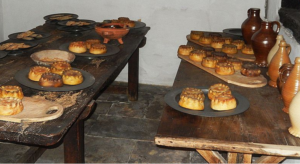
Tudor pies on pewter plates at Hampton Court [photographer: Chiswick Chap, creative commons license, Wikimedia Commons]
Academic essays on Renaissance food. The one that caught my eye was about bakers and the poor: “You had to be strong and dumb to be a baker, went an old saying. The pace was exhausting, frenetic, like a top chef’s kitchen…They slept in the bakeroom, because the stop-start work meant they could never get a full night’s rest”—p.19. Lung and eye problems from the flour dust were common. I didn’t know that occupation was so hazardous. Other chapters are about the use of distillation and the portrayal of banquets in early modern drama.
Take a Buttock of Beefe, by Verity Isitt. Ashford Press Publishing, 1987. 0907069576
The author selects from The Queen’s Closet Opened, a recipe collection assembled in 1655 for Queen Henrietta Maria (Charles I’s widow), and enhances the recipes with illustrations of period objects, historical background information, and a modern version of each recipe. For example, a recipe for “curd loaf” is matched with one for hot chocolate pudding, and a picture is offered of a period conical sugar loaf and the utensils used for cutting portions of sugar off the loaf.
Taste of Conquest: The Rise and Fall of the Three Great Cities of Spice, by Michael Krondl. Ballantine Books, 2007. 9780345480835
Krondl uses Venice, Lisbon, and Amsterdam to tell the story of the spice trade’s effect on European civilization. The time spans both Medieval and Renaissance periods. The Lisbon chapter discusses Vasco da Gama’s voyage and the thousands of pounds of spices he brought home to Portugal. The Amsterdam chapter has a section on the poor state of food and water on shipboard. A bibliography will help researchers find further information.
Tastes of the Empire: Foreign Foods in Seventeenth Century England, by Jillian Azevedo. McFarland & Company, 2017. 9781476668628
The author examines the increasing availability of foreign foods to the English and the impact it had on society. It discusses the uses of the exotic fruit pineapple, the uses of new spices in remedies, and the rising popularity of tea, coffee and chocolate. It has extensive footnotes and bibliographies.

The medieval kitchen in the north-east corner of Nanstein Castle in Germany. [public domain, Wikimedia Commons]
The Art of Cookery in the Middle Ages, by Terence Scully. Boydell Press, 1995. 9780851154305
Scully, an academic, examines late Medieval foodways in theory and practice. Chapters include beverages, table manners, foods for the sick, international foods. The section on aesthetics discusses Medieval preferences in the appearance of a dish. Includes an extensive bibliography.
The English Medieval Feast, by William Edward Mead. Barnes & Noble, 1967. [reprint of 1931 edition]
The author concentrates on the foodways of the upper classes in England. Did you know that almond milk was popular in Medieval times? See page 107. What kinds of fish might be eaten on Fridays is discussed on p.92. Eels as food were believed to hurt the voice, p. 218. There are extensive bibliographical notes.
Fast and Feast: Food in Medieval Society, by Bridget Ann Henisch. Pennsylvania State University Press, 1976.
The author draws on mostly English sources of 13-15th centuries. Menus, table settings, cooking methods, and mealtime entertainment are all covered. The footnote list is extensive, but the bibliography is rather short.
Food and Eating in Medieval Europe, edited by Martha Carlin and Joel T. Rosenthal. Hambledon Press, 1998. 1852851481
Essays by academics cover topics such as “Did the Peasants Really Starve in Medieval England?”, cannibalism, ale consumption, food in Canterbury Tales, and feasting in Anglo-Saxon times. Most essays have either bibliographical footnotes or an outright bibliography for further research.
Food Cultures in Medieval Europe, by Antonella Campanini, tr. By Leah M. Ashe. Peter Lang, 2016. 9782807610743
The author examines food of the poor vs. wealthy, how travel brought new foods and spices to Europe, the effects of Carnival and Lent on eating habits, and the roots of cuisine from Roman times. It has an extensive bibliography, but some of the sources are not in English.

A roasted peacock dressed with its feathers is served at a banquet, miniature of a manuscript of The Romance of Alexander the Great (“The Vows of the Peacock”), mid-15th century [public domain, Wikimedia Commons]
“My focus is on what the Anglo-Saxons ate and how their diet, their processes, and their food words and objects contributed to their identities.”—Introduction. Chapters cover iron, pottery and wood cooking utensils, the importance of quernstones, and food terminology. It has an extensive bibliography.
Holy Feast and Holy Fast: The Religious Significance of Food to Medieval Women, by Caroling Walker Bynum. University of California Press, 1987. 0520057228
“I explore the implications of food-related religious practices and of food images in the piety of medieval women,”—Introduction. Chapters include food in the lives of women saints and mystics, examines whether fasting was a form of anorexia, and the religious significance of food. If your character is a Medieval nun, this book would be worth consulting. It includes extensive bibliographical notes.
Medieval Food and Drink, edited by Mary-Jo Arn. Center for Medieval and Early Renaissance Studies, [1995?].
This is a compilation of essays by academics, with chapters on food and drink as portrayed in the Bayeux Tapestry, game as meat in Medieval France, a comparison of two period recipes for chicken cooked in milk with spices, and analyses of period cookbooks. Each chapter includes a bibliography.
HISTORICAL FOODWAYS OUTSIDE OF WESTERN EUROPE: BOOKS
Some of these books listed below are not arranged chronologically, so you may have to make use of the index or do some skimming to find the right time period.
Cabbage and Caviar: A History of Food in Russia, by Alison K. Smith. Reaktion Books, 2021. 9781789143645
Chapters 3 and 4 cover our periods of interest in Russian foodways. One passage talks about the reluctance of Russians to cultivate potatoes in the 1700s; plus, the role of hunting, and how food was preserved. There are extensive notes and a bibliography.
Food and Drink in Medieval Poland: Rediscovering a Cuisine of the Past, by Maria Dembinska, translated by Magdalena Thomas, revised and adapted by William Woys Weaver. University of Pennsylvania Press, 1999. 0812232240
This is adapted from the original 1963 Polish edition. “This volume is intended…to explore what is meant by “Polish cuisine’ and to connect this understanding to the fascinating period of the late 1300s when Poland burst forth on the international scene as a world power”—p.1. Line drawings of cooking utensils and plants enhance the text. A section in the back contains recipes adapted for modern cooks.
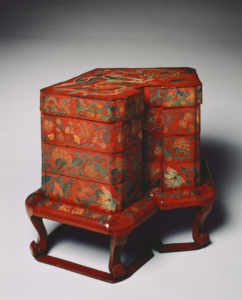
Tiered food box with stand, Japan, late 1700s
[Cleveland Museum of Art, public domain]
The first 4 or 5 chapters will be of most interest to historical novelists researching the equivalent of Medieval and Renaissance times in the West. Part two covers dietary culture in Japan in modern times, such as table etiquette, and the modern change from cooking over fire to electric appliances. Most of the sources in the bibliography are in Japanese.
Medieval Arab Cookery: Essays and Translations, by Maxime Rodinson, A.J. Arberry & Charles Perry. Prospect Books, 2001. 0907325912
Chapters include: “What to Order in Ninth-Century Baghdad,” “Elements of Arab Feasting,” “Couscous and its Cousins,” and “Notes on Persian Pasta.” Period recipes are included.
Origins of Chinese Food Culture, by Fu Chunjiang, tr. By Qiu Yao Hong. Asiapac Books, 2003. 9812293183
This is presented partly in graphic novel format, outlining Chinese food customs and how they came to be. The black and white illustrations include historical cooking utensils. Brief stories are included of origins of vinegar, century eggs, and dumplings; the importance of food artistry, and how chopsticks evolved. It’s a fun book to look through for fans of Chinese cuisine.
Slippery Noodles: A Culinary History of China, by Hsiang Ju Lin. Prospect Books, 2015. 9781909248373
“This is an account of how Chinese cooking evolved over two thousand years”—foreword. The first chapter is titled “In Medieval China,” but the rest don’t give a clue about the era from the chapter titles: “Bread and Pasta,” “The Book of Tea,” and “Bean Curd.” Many excerpts have not been translated into English before now. Each chapter has bibliographical notes, but many of the original sources are only in Chinese.
Stirring the Pot: A History of African Cuisine, by James C. McCann. Ohio University Press, 2009. 9780896802728
“The first two chapters describe the basic local components available to African cooks in the two or three millennia before the current era…”—introduction. Those cover seasonings, staples, and starches. Extensive notes and a bibliography will aid researchers.
Three World Cuisines: Italian, Mexican, Chinese, by Ken Albala. AltaMira Press/Rowman & Littlefield, 2012. 9780759121263
The most useful chapter for novelists will probably be “Historical Background,” which gives an overview of the three cuisines up through the industrial era. But the other chapters may also help: the one titled “Grains and Starches” discusses the history of wheat and rice in all three cuisines, plus corn, potatoes, and other starches. Each chapter contains recipes from each cuisine. It contains a bibliography and a glossary.

Still Life with Meat, Fish, Vegetables, and Fruit, by Jacob van Hulsdonck ca.1615-20 [Cleveland Museum of Art, public domain]
Eat Not This Flesh: Food Avoidances from Prehistory to the Present, 2nd edition, revised and enlarged, by Frederick J. Simoons. University of Wisconsin Press, 1994. 0299142507
If your characters are of a certain ethnic group in history which had food taboos, this would be a good source to consult. Examples of chapters: Pork, Beef, Horseflesh, and Fish. You may use it to research vegetarianism in the Middle Ages, or which civilizations accepted dogmeat as edible. The book has over 180 pages of notes and bibliographical material.
The Oxford Companion to Food, by Alan Davidson. Oxford, 1999. 0192115790
If you need a quick check on whether currants were eaten in the Middle Ages, this will give you the answer that they were first mentioned in European literature in the early 15th century. The Wikipedia article on currants does not state this. Another use for the book would be, say, if you were writing about your character making a voyage to Portugal in your chosen time period, the Portugal article in this book would give you a quick overview of Portuguese food. A third edition was published in 2014, which I have not seen, but it should have updated information and new discoveries.
WEBSITES THAT PROVIDE INTRODUCTIONS TO THE TOPICS
(I am listing non-commercial sites for the most part)
The Medieval Diet (British Library)
What Did Medieval Peasants Eat? (Medievalists.net)
Medieval Food (slideshow from Stanford University)
A Medieval Monk’s Menu (Historic Environment Scotland)
Tudor Dining (History Extra/BBC)
Tudor Food and Eating (Hampton Court Palace)
How Snobbery Helped to Take the Spice Out of European Cooking (National Public Radio)
The Spectacle of Renaissance Dining (KCET public TV station)
Food & Drink in the Elizabethan Era (World History Encyclopedia)
About the contributor: B.J. Sedlock is Lead Librarian and Coordinator of Metadata and Archives at Defiance College in Defiance, Ohio. She writes book reviews and articles for The Historical Novels Review, and has contributed to The Sondheim Review.

